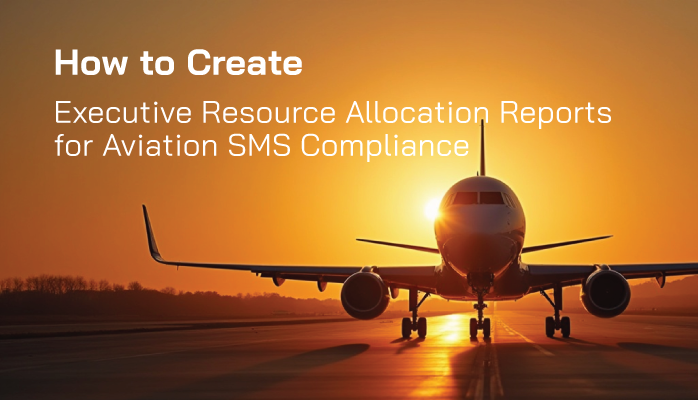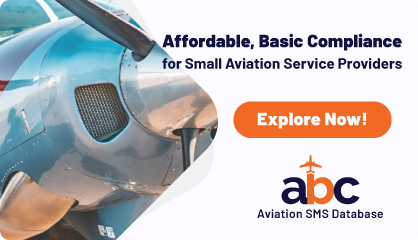Ensuring Compliance and Safety Through Robust Aviation SMS

In the high-stakes world of aviation, a robust Safety Management System (SMS) is critical for mitigating risks and ensuring safety. For aviation safety managers and accountable executives—senior leaders responsible for SMS oversight—demonstrating compliance with regulatory standards, such as those set by the International Civil Aviation Organization (ICAO) or national civil aviation authorities like the FAA or EASA, is a top priority.
One powerful tool for showcasing compliance during regulatory inspections is a resource allocation report. This report summarizes investments in the four SMS pillars—safety policy, safety risk management, safety assurance, and safety promotion—proving that the organization has committed adequate financial, human, and technological resources to safety.
Creating a resource allocation report can be challenging, especially for new safety managers who struggle to train staff on SMS concepts and align executives on compliance goals. This evergreen blog article provides a step-by-step guide to crafting a clear, impactful report, complete with examples and practical tips. Whether you’re preparing for an FAA audit or an EASA inspection, this resource will help you demonstrate SMS compliance with confidence.
Why a Resource Allocation Report Matters
A Safety Management System is a structured framework for identifying hazards, assessing risks, and implementing risk controls to prevent incidents. The accountable executive, typically the CEO, COO, or a designated senior leader, is responsible for ensuring the SMS is adequately resourced. Regulatory bodies scrutinize resource allocation to verify that organizations prioritize safety over cost-cutting.
A resource allocation report serves as evidence of this commitment. By summarizing investments in each SMS pillar, the report shows regulators how budgets, personnel, and technology support safety policy, safety risk management, safety assurance, and safety promotion.
For safety managers, the report also simplifies training by providing a tangible example of SMS in action. Let’s explore how to create a report that meets regulatory expectations and strengthens your safety culture.
Step 1: Understand the Four SMS Pillars
Before creating the report, ensure you and the accountable executive understand the four SMS pillars, as defined by ICAO Annex 19:
- Safety Policy and Objectives: Establishes the organization’s commitment to safety, including policies, objectives, and responsibilities.
- Safety Risk Management (SRM): Involves identifying hazards, assessing risks, and implementing controls.
- Safety Assurance: Monitors SMS performance through audits, data analysis, and corrective actions.
- Safety Promotion: Fosters a safety culture through training, communication, and engagement.
Each pillar requires specific resources to function effectively. The report must clearly link investments to these pillars to demonstrate compliance.
Actionable Tip: Review your organization’s SMS manual and regulatory requirements (e.g., FAA Part 5 or EASA SMS guidelines) to ensure the report aligns with expectations. Share a one-page summary of the pillars with the accountable executive to set the stage.
Related Aviation SMS Manual Articles
- 3 Best Practices for Your Aviation SMS Manual
- Tips Writing SMS Manuals With Aviation Safety Database Solutions
- Best Practices Reviewing Aviation SMS Manuals
Step 2: Gather Data on Resource Investments

To create a comprehensive report, collect data on financial, human, and technological resources allocated to each SMS pillar over a defined period (e.g., the past year). Involve key stakeholders, such as finance, HR, and safety teams, to ensure accuracy.
Data to Collect
- Financial Resources: Budgets for training, software, audits, equipment, or safety campaigns.
- Human Resources: Number of safety personnel, hours spent on training, or executive time dedicated to SMS oversight.
- Technological Resources: Investments in hazard reporting systems, data analytics tools, or e-learning platforms.
- Outcomes: Measurable results, such as reduced incident rates or improved audit scores, to show the impact of investments.
Example Data Collection
A regional airline gathers the following for its report:
- Safety Policy: $5,000 for policy development and $2,000 for intranet hosting.
- SRM: $30,000 for a hazard reporting app and $10,000 for risk assessment training.
- Safety Assurance: $20,000 for external audits and $15,000 for a safety dashboard.
- Safety Promotion: $15,000 for SMS training and $5,000 for a safety newsletter.
Actionable Tip: Create a spreadsheet to track investments, categorizing them by pillar, resource type, and cost. Share it with the accountable executive for review before drafting the report.
Step 3: Structure the Resource Allocation Report
A well-structured report is clear, concise, and tailored to regulators. Use the following format to organize your content:
- Introduction: Explain the report’s purpose and the organization’s commitment to SMS.
- Overview of SMS Pillars: Briefly describe each pillar and its role in safety.
- Resource Allocation by Pillar: Detail investments for each pillar, with examples and outcomes.
- Summary and Commitment: Highlight total investments and the accountable executive’s pledge to ongoing support.
- Appendices: Include supporting documents, like budget breakdowns or audit reports.
Tips for Clarity
- Use tables or bullet points to summarize investments.
- Include visuals, like charts, to illustrate resource distribution.
- Keep language straightforward, avoiding jargon to ensure accessibility.
Actionable Tip: Draft the report in a word processor and use a template with headings and tables. Share a draft with the safety team for feedback before finalizing.
Step 4: Detail Investments for Each SMS Pillar
For each pillar, describe the resources allocated, their purpose, and their impact. Include specific examples and measurable outcomes to strengthen your case.
Safety Policy and Objectives
- Purpose: Resources ensure the safety policy is developed, communicated, and endorsed by leadership.
- Resources:
- Financial: Budgets for policy drafting, legal reviews, and communication tools.
- Human: Safety personnel to write the policy and trainers to educate staff.
- Technological: Intranet or document management systems to share the policy.
- Example: A maintenance organization spends $6,000 on a safety consultant to draft a policy aligned with EASA standards and $3,000 on posters and an intranet platform to share it with 200 employees. The accountable executive attends a one-hour briefing to review and sign the policy, demonstrating leadership. Outcome: 95% of staff report awareness of the policy within three months.
- Impact: Clear policy communication fosters a unified safety culture.
Safety Risk Management
- Purpose: Resources enable hazard identification, risk assessment, and mitigation.
- Resources:
- Financial: Budgets for risk assessment tools or mitigation measures (e.g., equipment upgrades).
- Human: Safety analysts and frontline staff trained in hazard reporting.
- Technological: Hazard reporting apps or data analytics platforms.
- Example: An airport allocates $40,000 for a mobile hazard reporting app and $15,000 to train 100 ground crew on its use. The app logs 50 hazards in six months, leading to a $25,000 investment in runway lighting to address visibility issues. Outcome: Near-miss incidents drop by 20%.
- Impact: Proactive risk management prevents incidents and enhances safety.
Safety Assurance
- Purpose: Resources support audits, performance monitoring, and corrective actions.
- Resources:
- Financial: Budgets for audits, data analysis tools, or corrective measures.
- Human: Auditors and analysts to review performance data.
- Technological: Safety dashboards or audit management software.
- Example: A cargo airline invests $25,000 in an external SMS audit and $10,000 in a safety dashboard tracking KPIs, like incident rates. Two safety analysts spend 15 hours monthly analyzing data, identifying a gap in pilot training. The accountable executive approves $12,000 for additional simulator sessions. Outcome: Pilot error incidents decrease by 15%.
- Impact: Continuous monitoring ensures SMS effectiveness and compliance.
Safety Promotion
- Purpose: Resources foster a safety culture through training and communication.
- Resources:
- Financial: Budgets for training programs or safety campaigns.
- Human: Trainers and safety managers to deliver education and communication.
- Technological: E-learning platforms or communication tools.
- Example: A regional airline spends $20,000 on an e-learning platform for SMS training and $5,000 on a quarterly safety newsletter. The accountable executive hosts a virtual safety town hall, streamed via a $2,000 video platform, to recognize hazard reporters. Outcome: Employee hazard reporting increases by 30%.
- Impact: Engaged staff strengthen the safety culture.
Actionable Tip: For each pillar, include a short case study in the report, like the examples above, to show regulators how resources translate into safety improvements.
Step 5: Summarize Total Investments and Commitment

Conclude the report with a summary of total investments across all pillars and a statement from the accountable executive reinforcing their commitment to SMS. This ties the report together and leaves a strong impression on regulators.
Example Summary
Total Investments (2024):
- Safety Policy: $9,000
- Safety Risk Management: $80,000
- Safety Assurance: $47,000
- Safety Promotion: $27,000
- Grand Total: $163,000
Executive Commitment: “As the accountable executive, I am committed to ensuring our SMS is fully resourced to protect our people, assets, and reputation. These investments reflect our dedication to continuous improvement, compliance, and a safety-first culture.”
Signed: [Accountable Executive’s Name], CEO
Actionable Tip: Include a pie chart in the report showing the percentage of resources allocated to each pillar, making it visually clear how investments are distributed.
Step 6: Prepare for Regulatory Inspections
To maximize the report’s impact during inspections, take these steps:
- Organize Supporting Documents: Attach budget breakdowns, training logs, or audit reports in the appendices to substantiate claims.
- Train Staff: Ensure safety managers and key staff can explain the report’s contents, as regulators may ask questions.
- Engage the Accountable Executive: Have the executive present the report during the inspection to demonstrate leadership.
- Update Annually: Refresh the report yearly to reflect new investments and outcomes, keeping it evergreen.
Actionable Tip: Conduct a mock inspection with the safety team, practicing how to present the report and answer regulator questions about resource allocation.
Related Aviation SMS Audit Articles
- How Often Should You Conduct Aviation SMS Audit
- 9 Best Strategies for Aviation Safety Audit Preparation [Free Audit Checklists]
- Aviation Safety Audit Preparation - 4 Free SMS Audit Templates
Overcoming Common Challenges
New safety managers often struggle to train staff on SMS concepts and engage busy executives. Here’s how to address these challenges when creating the report:
- Simplify SMS Concepts: Use the report as a training tool, explaining how resources “power” each pillar, like fuel for an aircraft.
- Streamline Data Collection: Collaborate with finance and HR early to gather data efficiently, reducing the burden on safety managers.
- Secure Executive Buy-In: Schedule a short briefing to review the report draft with the accountable executive, emphasizing its role in compliance.
Actionable Tip: Create a one-page infographic summarizing the report’s key points and share it with staff during SMS training to make resource allocation relatable.
Example Resource Allocation Report Excerpt
Resource Allocation Report: 2024
Introduction: This report outlines [Organization Name]’s investments in our SMS, demonstrating compliance with FAA Part 5 and ICAO Annex 19.
Safety Risk Management Investments:
- Hazard Reporting App: $40,000 for a mobile app enabling ground crew to report hazards, logging 50 reports in six months.
- Runway Lighting Upgrade: $25,000 to address visibility hazards, reducing near-misses by 20%.
- Training: $15,000 to train 100 staff on risk assessment, enhancing hazard identification.
Outcome: Proactive risk mitigation strengthens safety performance.
[Similar sections for other pillars, followed by a summary and executive statement.]
Actionable Tip: Use this excerpt as a template, customizing it with your organization’s data and examples.
Conclusion: Showcase Compliance With a Robust Report
A resource allocation report is a powerful tool for demonstrating SMS compliance, showing regulators that your organization prioritizes safety through strategic investments. By summarizing resources for each SMS pillar—safety policy, safety risk management, safety assurance, and safety promotion—you provide clear evidence of commitment and leadership. For new safety managers, the report also simplifies training by illustrating how SMS works in practice.
Start by gathering data on your organization’s investments and drafting a report using the steps and examples above. Engage the accountable executive to review and endorse it, ensuring it reflects their leadership. With a well-crafted report, you’ll not only ace regulatory inspections but also foster a safety culture that protects lives and assets for years to come.
Call to Action: Ready to demonstrate SMS compliance? Begin drafting your resource allocation report today. Share this article with your team to align on investments and training strategies.






